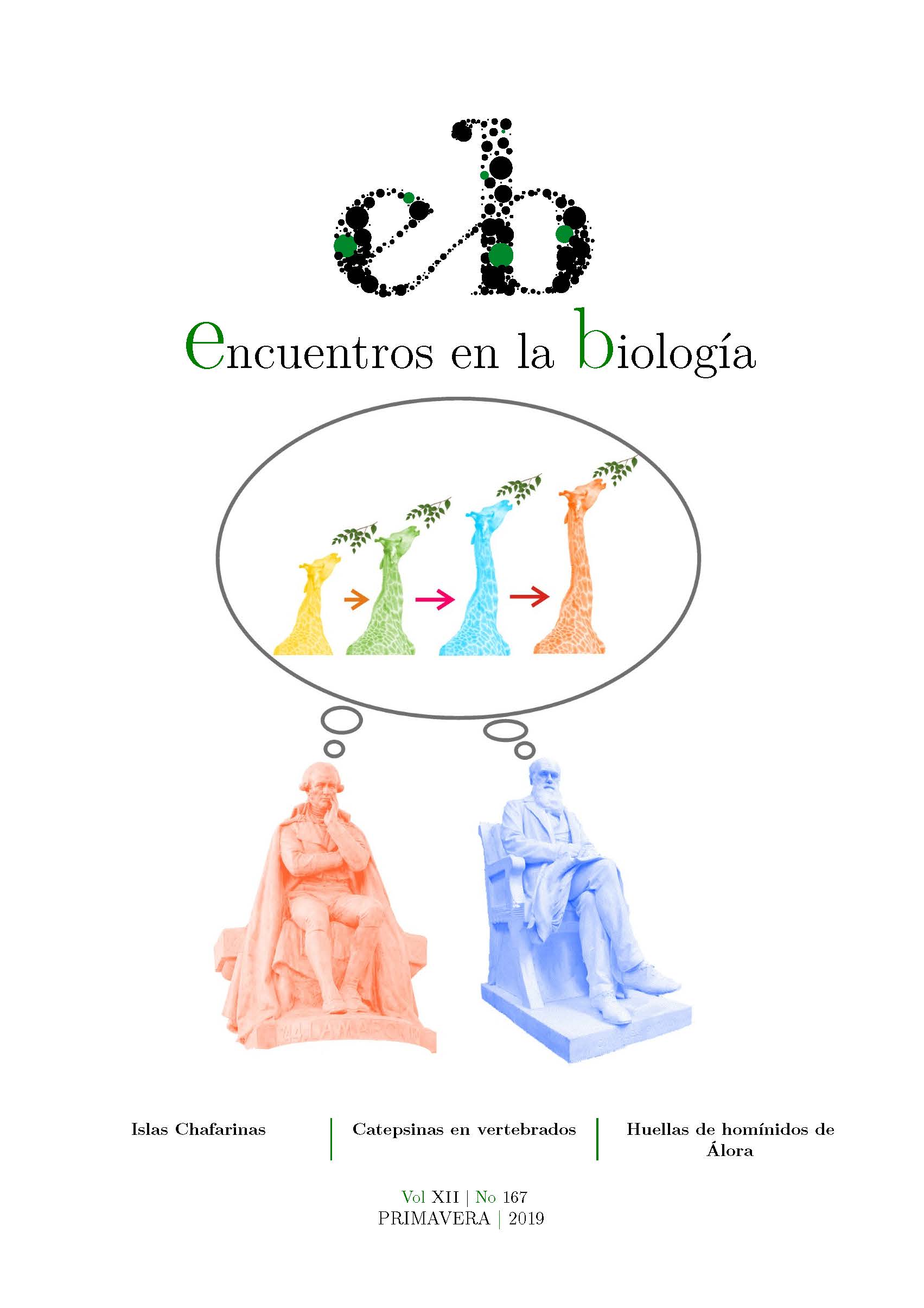Evolutionary diversification of cathepsin genes in vertebrates
DOI:
https://doi.org/10.24310/enbio.v12i167.17477Keywords:
paralog genes, molecular evolution, duplication, phylogeny of cathepsinsAbstract
Paralogous genes are a clear example of duplications and source of diversification in the evolution of the genomes of living beings. Here we addressed CTS genes that give rise to the proteolytic enzymes called cathepsins. After a thorough search in bibliographic databases and molecular sequences we found information about these genes is confusing. In order to identify the processes involved in their evolutionary diversification since the origin of terrestrial vertebrates to the present we analysed the phylogenetic relationships between the amino acid sequences of cathepsins. The species included in this study belong mainly to some specific taxa such as Mammals (Primates, Rodents, Ungulates, Carnivora and Marsupials), Birds and Bony Fishes. In general terms, among the 32 genes found in vertebrates, at least 4 of them have arisen due to duplications subsequent to the colonization of the terrestrial environment and 2 of them seem to have been lost in the lineage of the Birds. Other modifications observed are mainly due to mutations such as amino acid substitutions or insertions/deletions (indels).
Downloads
Metrics
Publication Facts
Reviewer profiles N/A
Author statements
Indexed in
-
—
- Academic society
- N/A
- Publisher
- Uma Editorial. Universidad de Málaga
References
Hoffmann F y otros. Evolution of the Globin Gene Family in Deu- terostomes: Lineage-Specific Patterns of Diversification and Attri- tion. Mol. Biol. Evol., 29: 1735-1745, 2012.
Carroll SB y otros. From DNA to diversity: molecular genetics and the evolution of animal design. Blackwell Science, Hoboken, Nueva Jersey, 2001.
Sun B y Chi H. Cathepsin S of Sciaenops ocellatus: Identification, transcriptional expression and enzymatic activity. Int. J. Biol. Ma- cromol., 82: 76-82, 2016.
Wang Y y otros. Identification and activity of a paralog of cat- hepsin S from yellow catfish (Pelteobagrus fulvidraco) involved in immune response. Fish Shellfish Immunol., 61: 16-23, 2017.
Zhou J y otros. Evolutionary History of Cathepsin L (L-like) Family Genes in Vertebrates. Int. J. Biol. Sci., 11: 1016-1025, 2015.
Sol-Church y otros. Evolution of placentally expressed cathepsins. Biochem. Biophys. Res. Commun., 293: 23–29, 2002.
Gallwitz M y otros. Expansion of the mast cell chymase locus over the past 200 million years of mammalian evolution. Immunogene- tics, 58: 655-669, 2006.
Mason R. Emerging functions of placental cathepsins. Placenta, 29: 385-390, 2008
Raymond W y otros. How immune peptidases change specificity: cathepsin G gained tryptic function but lost eiciency during pri- mate evolution. J. Immunol., 185: 5360-5368, 2010.
Oikawa D y Iwawaki T. Positive contribution of IRE1––XBP1 pathway to the expression of placental cathepsins. Biochem. Biophys. Res. Commun., 433: 426-431, 2013
Kirkegaard T y Jäättelä M. Lysosomal involvement in cell death and cancer. Biochim. Biophys. Acta, 1793: 746-754, 2009.
Downloads
Published
How to Cite
Issue
Section
License
Esta obra está bajo licencia internacional Creative Commons Reconocimiento-NoComercial-CompartirIgual 4.0.
Esta revista provee acceso libre inmediato a su contenido bajo el principio de hacer disponible gratuitamente la investigación al público. Todos los contenidos publicados en Encuentros en la Bilogía están sujetos a la licencia Creative Commons Reconocimento-NoComercia-Compartirigual 4.0 cuyo texto completo puede consultar en <http://creativecommons.org/licenses/by-nc-sa/4.0>
Se pueden copiar, usar, difundir, transmitir y exponer públicamente, siempre que:
Se cite la autoría y la fuente original de su publicación (revista, editorial y URL de la obra).
No se usen para fines comerciales.
Se mencione la existencia y especificaciones de esta licencia de uso
Los derechos de autor son de dos clases: morales y patrimoniales. Los derechos morales son prerrogativas perpetuas, irrenunciables, intransferibles, inalienables, inembargables e imprescriptibles. De acuerdo con la legislación de derechos de autor, Encuentros en la Biología reconoce y respeta el derecho moral de los autores/as, así como la titularidad del derecho patrimonial, el cual será cedido a la Universidad de Málaga para su difusión en acceso abierto. Los derechos patrimoniales, se refieren a los beneficios que se obtienen por el uso o divulgación de las obras. Encuentros en la Biología se publica en open access y queda autorizada en exclusiva para realizar o autorizar por cualquier medio el uso, distribución, divulgación, reproducción, adaptación, traducción o transformación de la obra.
Es responsabilidad de los autores/as obtener los permisos necesarios de las imágenes que están sujetas a derechos de autor.
Los autores/as cuyas contribuciones sean aceptadas para su publicación en esta revista conservarán el derecho no exclusivo de utilizar sus contribuciones con fines académicos, de investigación y educativos, incluyendo el auto-archivo o depósito en repositorios de acceso abierto de cualquier tipo.
La edición electrónica de esta revista esta editada por la Editorial de la Universidad de Málaga (UmaEditorial), siendo necesario citar la procedencia en cualquier reproducción parcial o total.






